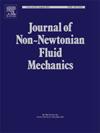Pore-network modeling of viscoplastic flows: Exploring the Hele-Shaw cell flow analogy
IF 2.8
2区 工程技术
Q2 MECHANICS
引用次数: 0
Abstract
We explore the relationship between a yield stress fluid flow in a Hele-Shaw cell with irregular walls, and a non-Darcy 2D porous medium flow with limiting pressure gradient. The continuum (Hele-Shaw) flow is a much-studied simplification of a cementing displacement flow model, solved via a variational formulation that leads to a convex streamfunction minimization problem. Our interest is with the analogy between the discretization used for the numerical solution and network flows that model the associated porous media flow, i.e. via the pore-throat approach. A staggered mesh, with pressure nodes at the cell corners and streamfunction nodes at the cell center is used for the continuum problem, which naturally separates into a network representation comprising primal and dual graphs, linking streamfunction and pressure nodes, respectively. We show explicitly how the continuum model defines a network model and vice versa. We develop the variational form of the network flow, including an appropriate (discrete) streamfunction minimization and a discrete version of the principle of virtual work.
Two network models are explored, based on different interpretations of the minimization problem. The network flow results are compared with analogous computed continuum flow results in 3 specific geometries. We find that our network model I, which is the most natural interpretation of the continuum model as a network flow using our discretization, generally under-predicts flow rates. This is problematic from the perspective of considering the network flow as an approximation to the porous media or Hele-Shaw flow. Network model II rectifies this situation, via a pressure interpolation method. In our examples we find that the network II flow converges to the continuum flow as the mesh and network are refined. This is not the usual comparison made, as in many pore-throat models the network is fixed according to the underlying pore-space geometry. Despite the differences, both network models have their own advantages and disadvantages. Network model I offers a more natural way of modeling the flow and is easier to apply, for example to complex meshes, e.g. unstructured triangular. Network model II gives the more accurate physical representation of the Hele-Shaw flow. Lastly, we have developed approximate algebraic relationships for the total flow rate as a function of the total applied pressure gradient, both close to the critical onset pressure and for large pressure gradients. These correlations align well with previous findings for Bingham fluid flows in porous media.
粘塑性流动的孔隙网络建模:探索Hele-Shaw细胞流动类比
我们探索了不规则壁Hele-Shaw槽内屈服应力流体流动与具有极限压力梯度的非达西二维多孔介质流动之间的关系。连续流(Hele-Shaw)是一种被广泛研究的简化固井置换流动模型,通过变分公式解决,从而导致凸流函数最小化问题。我们感兴趣的是用于数值解的离散化和模拟相关多孔介质流动的网络流之间的类比,即通过孔喉方法。连续问题采用交错网格,压力节点位于单元的角落,流函数节点位于单元的中心,它自然地分离成一个由原始图和对偶图组成的网络表示,分别连接流函数节点和压力节点。我们明确地展示了连续体模型如何定义网络模型,反之亦然。我们开发了网络流的变分形式,包括适当的(离散)流函数最小化和虚功原理的离散版本。基于对最小化问题的不同解释,探讨了两种网络模型。将网络流计算结果与3种特定几何形状的连续流计算结果进行了比较。我们发现,我们的网络模型I是使用我们的离散化对连续统模型作为网络流的最自然的解释,通常低于预测流量。从考虑网络流近似于多孔介质或Hele-Shaw流的角度来看,这是有问题的。网络模型II通过压力插值方法纠正了这种情况。在算例中,我们发现随着网格和网络的细化,网络II流收敛于连续流。这不是通常的比较,因为在许多孔喉模型中,网络是根据底层孔隙空间几何形状固定的。尽管存在差异,但两种网络模式都有各自的优点和缺点。网络模型I提供了一种更自然的流建模方式,并且更容易应用,例如复杂的网格,例如非结构化三角形。网络模型II给出了更准确的Hele-Shaw流的物理表示。最后,我们建立了总流量作为总施加压力梯度函数的近似代数关系,既接近临界起始压力,也适用于大压力梯度。这些相关性与先前在多孔介质中宾厄姆流体流动的发现很好地吻合。
本文章由计算机程序翻译,如有差异,请以英文原文为准。
求助全文
约1分钟内获得全文
求助全文
来源期刊
CiteScore
5.00
自引率
19.40%
发文量
109
审稿时长
61 days
期刊介绍:
The Journal of Non-Newtonian Fluid Mechanics publishes research on flowing soft matter systems. Submissions in all areas of flowing complex fluids are welcomed, including polymer melts and solutions, suspensions, colloids, surfactant solutions, biological fluids, gels, liquid crystals and granular materials. Flow problems relevant to microfluidics, lab-on-a-chip, nanofluidics, biological flows, geophysical flows, industrial processes and other applications are of interest.
Subjects considered suitable for the journal include the following (not necessarily in order of importance):
Theoretical, computational and experimental studies of naturally or technologically relevant flow problems where the non-Newtonian nature of the fluid is important in determining the character of the flow. We seek in particular studies that lend mechanistic insight into flow behavior in complex fluids or highlight flow phenomena unique to complex fluids. Examples include
Instabilities, unsteady and turbulent or chaotic flow characteristics in non-Newtonian fluids,
Multiphase flows involving complex fluids,
Problems involving transport phenomena such as heat and mass transfer and mixing, to the extent that the non-Newtonian flow behavior is central to the transport phenomena,
Novel flow situations that suggest the need for further theoretical study,
Practical situations of flow that are in need of systematic theoretical and experimental research. Such issues and developments commonly arise, for example, in the polymer processing, petroleum, pharmaceutical, biomedical and consumer product industries.

 求助内容:
求助内容: 应助结果提醒方式:
应助结果提醒方式:


